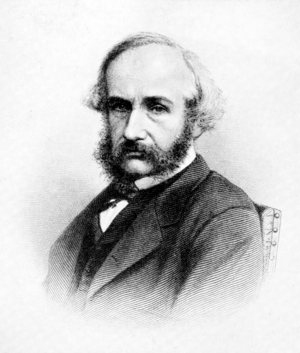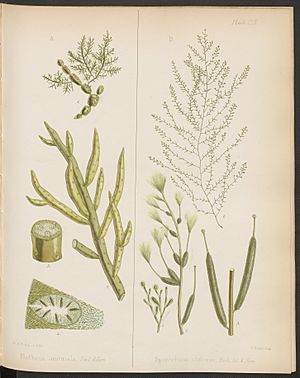William Henry Harvey facts for kids
Quick facts for kids
William Henry Harvey
FRS
|
|
|---|---|
 |
|
| Born | 5 February 1811 Limerick, County Limerick, Ireland
|
| Died | 15 May 1866 (aged 55) Torquay, Devon, England
|
| Nationality | Irish |
| Other names | W.H Harvey |
| Known for | A Manual of the British Algae |
| Spouse(s) | Miss Phelps (m 1861) |
| Scientific career | |
| Fields | Botanist |
| Author abbrev. (botany) | Harv. |
William Henry Harvey (born February 5, 1811 – died May 15, 1866) was an Irish botanist. He was a special expert in studying algae, which are simple plant-like organisms often found in water. He was also known as a phycologist, which is a scientist who studies algae.
Contents
Early Life and Discoveries
William Henry Harvey was born in 1811 near Limerick, Ireland. He was the youngest of 11 children. His father, Joseph Massey Harvey, was a successful merchant and a Quaker.
William went to Ballitore School in County Kildare. By the time he was 15, he was already very interested in algae. After school, he joined his family's business.
William became a top expert on algae and bryophytes, which are mosses. He wrote many important books about them. Some of his famous books include A Manual of the British Algae (1841) and Phycologia Britannica (1846–51).
In 1831, Harvey found a new type of moss in Ireland called Hookeria laetevirens. This discovery led to a lifelong friendship with Sir William Jackson Hooker. Hooker was a famous botany professor at Glasgow University. He saw William's talent and helped him by lending him books and plant samples. Soon, Hooker asked William to write parts of his own books about algae.
Adventures and Travels
In 1835, Harvey traveled to South Africa on a ship called "Carnatic." He went with his brother Joseph. Joseph had been chosen for a government job there. But Joseph got sick, so William took over his duties. They left South Africa together in 1836, but sadly, Joseph died during the trip back to Britain.
William returned to Cape Town and officially became the treasurer-general. He lived at Bishop's Court. He would wake up early to collect plants in the mountains or by the sea. Then, he would work on studying the plants at night. He even joked that he was "Her Majesty's pleasurer general" because he took so many trips to collect plants.
He became good friends with Baron von Ludwig, who had famous gardens in Cape Town. William even dedicated one of his books, Genera of South African Plants, to him. With help from others, he started writing a big book called Flora Capensis about South African plants. He saw the first three volumes published before he passed away. Due to illness, he resigned from his job and returned home in 1842.
In 1844, Harvey became the curator of the plant collection (Herbarium) at Trinity College Dublin. In 1848, he became a Professor of Botany at the Royal Dublin Society.
In 1853, he went on a three-year journey. He visited many places, including South Africa, Ceylon, Australia, New Zealand, Tonga, Fiji, and Chile. When he came back, he published more important books about plants from North America and South Africa. In 1858, he became a Professor of Botany at Trinity College Dublin.
William Henry Harvey died from tuberculosis on May 15, 1866, in Torquay, England, where he was buried.
Contributions to Botany
After publishing his 1858 book, The genera of South African plants, Harvey asked readers in South Africa to send him plant samples. He wanted to document all the plants in the Cape region. This led to him writing to Mary Elizabeth Barber, a nature enthusiast. At first, Mary didn't tell him she was a woman because, back then, it was unusual for women to be involved in science.
Mary Barber became one of Harvey's main helpers. She sent him about 1,000 different plant species from South Africa. She also included notes on each one. She helped him name and classify many new species.
Harvey himself described over 750 different species and more than 75 groups (genera) of algae. His book Phycologia Britannica and Nereis Australis Or Algae of the Southern Ocean made him very famous. His book Phycologia Australica is one of the most important books about algae from the 1800s. It has five volumes and came from his many trips collecting algae on Australian shores.
Because of his extensive work, William Henry Harvey earned the title "father of Australian Phycology." In 1858, he was chosen as a Fellow of the Royal Society, which is a great honor for scientists.
Harvey's Legacy
Many of the plant samples collected by Harvey are still kept in museums and universities today. About 600 of his specimens from Ireland, Ceylon, Australia, and Tasmania are in the Ulster Museum Herbarium (BEL). His main collection is at the Trinity College Herbarium in Dublin. Other collections of his specimens are in places like University College, Cork, Ireland, and various herbaria in the US and Australia.
In Harvey's time, scientists often traded plant samples with each other. They also got help from people who collected plants as a hobby. His 1841 book, Manual of the British Algae, was dedicated to Amelia Griffiths, a British beachcomber. In his books, Harvey often mentioned the names of the collectors who helped him find different species. He thanked many people, including Rev Pollexfen, Dr McBain, Miss White, Miss Magdalene Turner, and Mrs Margaret Gatty.
Harvey showed his appreciation by naming new species after some of these helpers. For example, he named Cladophora magdalenae after Magdalene Turner. He also honored Susan Fereday by naming Dasya feredayae and Nemastoma feredayae after her.
When you see the author abbreviation Harv. next to a plant name, it means William Henry Harvey was the one who first described that plant.
Images for kids



